Solar Flare Effects Observed over Mexico during 30–31 March 2022
Abstract
1. Introduction
2. Description of the Considered Flares
3. Data Used
4. Results of Observations
4.1. Flare Effects by VIS Data
4.1.1. Ionospheric Conditions by Ionograms
4.1.2. Estimation of the Reflected Signal Attenuation in Mexico
4.1.3. Correlation with Different Ranges of EUV and X-ray Radiation
4.2. Flare Detection by GNSS Data
4.2.1. Features of dI Response
4.2.2. Correlation with Different Ranges of EUV and X-ray Radiation
5. Conclusions
Supplementary Materials
Author Contributions
Funding
Data Availability Statement
Acknowledgments
Conflicts of Interest
References
- Bryunelli, B.E.; Namgaladze, A.A. Physics of the Ionosphere; Nauka: Moscow, Russia, 1988; 528p, ISBN 5-02-000716-1. [Google Scholar]
- Davies, K. Ionospheric Radio Propagation; Monograph 80; National Bureau of Standards: Gaithersburg, MD, USA, 1965; 487p. [Google Scholar]
- Mitra, A.P. Ionospheric Effect of Solar Flares; Reidel: Norwell, MA, USA, 1974. [Google Scholar]
- Berngard, O.I.; Ruohoniemi, J.M.; Nishitani, N.; Shepherd, S.G.; Bristow, W.A.; Miller, E.S. Attenuation of decameter wavelength sky noise during X-ray solar flares in 2013–2017 based on the observations of midlatitude HF radars. J. Atmos. Sol.-Terr. Phys. 2018, 173, 1–13. [Google Scholar] [CrossRef]
- Mendillo, M.; Evans, J.V. Incoherent scatter observations of the ionospheric response to a large solar flare. Radio Sci. 1974, 9, 197–203. [Google Scholar] [CrossRef]
- Blagoveschensky, D.V.; Sergeeva, M.; Raita, T. Riometer absorption during four similar storms. Adv. Space Res. 2022, 69, 1. [Google Scholar] [CrossRef]
- Barta, V.; Sátori, G.; Berény, K.A.; Kis, A.; Williams, E. Effects of solar flares on the ionosphere as shown by the dynamics of ionograms recorded in Europe and South Africa. Ann. Geophys. 2019, 37, 747–761. [Google Scholar] [CrossRef]
- Zaalov, N.Y.; Moskaleva, E.V.; Rogov, D.D.; Zernov, N.N. Influence of X-ray and polar cap absorptions on vertical and oblique sounding ionograms on different latitudes. Adv. Space Res. 2015, 56, 2527–2541. [Google Scholar] [CrossRef]
- Liu, L.B.; Wan, W.X.; Chen, Y.D.; Le, H.J. Solar activity effects of the ionosphere: A brief review. Chin. Sci. Bull. 2011, 56, 1202–1211. [Google Scholar] [CrossRef]
- Mendillo, M.; Klobuchar, J.A.; Fritz, R.B.; da Rosa, A.V.; Kersle, L.; Yeh, K.C.; Flaherty, B.J.; Rangaswamy, S.; Schmid, P.E.; Evans, J.V.; et al. Behavior of the Ionospheric F Region during the Great Solar Flare of 7 August 1972. J. Geophys. Res. 1974, 79, 4. [Google Scholar]
- Berdermann, J.; Kriegel, M.; Banyґs, D.; Heymann, F.; Hoque, M.M.; Wilken, V.; Borries, C.; HeBelbarth, A.; Jakowski, N. Ionospheric response to the X9.3 Flare on 6 September 2017 and its implication for navigation services over Europe. Space Weather 2018, 16, 1604–1615. [Google Scholar] [CrossRef]
- Rathore, V.S.; Kumar, S.; Singh, A.K.; Singh, A.K. Ionospheric response to an intense solar flare in equatorial and low latitude region. Indian J. Phys. 2018, 92, 1213–1222. [Google Scholar] [CrossRef]
- Kelley, M.C. The Earth’s Ionosphere: Plasma Physics and Electrodynamics, 2nd ed.; International Geophysics Series 96; Elsevier: Amsterdam, The Netherlands, 2009; ISBN 978-0-12-088425-4. [Google Scholar]
- Hunsucker, R.D.; Hargreaves, J.K. The High-Latitude Ionosphere and Its Effects on Radio Propagation; Cambridge University Press: Cambridge, UK, 2003. [Google Scholar]
- Dmitriev, A.V.; Yeh, H.-C.; Chao, J.-K.; Veselovsky, I.S.; Su, S.-Y.; Fu, C.C. Top-side ionosphere response to extreme solar events. Ann. Geophys. 2006, 24, 1469–1477. [Google Scholar] [CrossRef]
- Mendillo, M.; Erickson, P.J.; Zhang, S.-R.; Mayyasi, M.; Narvaez, C.; Thiemann, E.; Chamberlain, P.; Andersson, L.; Peterson, W. Flares at Earth and Mars: An ionospheric escape mechanism? Space Weather 2018, 16, 1042–1056. [Google Scholar] [CrossRef]
- Leonovich, L.A.; Tashchilin, A.V. Disturbances in the Topside Ionosphere during Solar Flares. Geomagn. Aeron. 2008, 48, 759–767. [Google Scholar] [CrossRef]
- Afraimovich, E.L.; Astafyeva, E.I.; Demyanov, V.V.; Edemskiy, I.K.; Gavrilyuk, N.S.; Ishin, A.B.; Kosogorov, E.A.; Leonovich, L.A.; Lesyuta, O.S.; Palamartchouk, K.S.; et al. A review of GPS/GLONASS studies of the ionospheric response to natural and anthropogenic processes and phenomena. J. Space Weather Space Clim. 2013, 3, A27. [Google Scholar] [CrossRef]
- Liu, X.; Liu, J.; Wang, W.; Zhang, S.-R.; Zhang, K.; Lei, J.; Liu, L.; Chen, X.; Li, S.; Zhang, Q.-H.; et al. Explaining solar flare-induced ionospheric ion upflow at Millstone Hill (42.6 N). J. Geophys. Res.-Space 2022, 127, e2021JA030185. [Google Scholar] [CrossRef]
- Habarulema, J.B.; Tshisaphungo, M.; Katamzi-Joseph, Z.T.; Matamba, T.M.; Nndanganeni, R. Ionospheric response to the M- and X-class solar flares of 28 October 2021 over the African sector. Space Weather 2022, 20, e2022SW003104. [Google Scholar] [CrossRef]
- Le, H.J.; Liu, L.B.; Chen, Y.D.; Zhang, H. Anomaly distribution of ionospheric total electron content responses to some solar flares. Earth Planet. Phys. 2019, 3, 481–488. [Google Scholar] [CrossRef]
- Yasyukevich, Y.; Astafyeva, E.; Padokhin, A.; Ivanova, V.; Syrovatskii, S.; Podlesnyi, A. The 6 September 2017 X-class solar flares and their impacts on the ionosphere, GNSS, and HF radio wave propagation. Space Weather 2018, 16, 1013–1027. [Google Scholar] [CrossRef] [PubMed]
- Reinisch, B.W.; Galkin, I.A. Global ionospheric radio observatory (GIRO). Earth Planets Space 2011, 63, 377–381. [Google Scholar] [CrossRef]
- Maletckii, B.; Yasyukevich, Y.; Vesnin, A. Wave Signatures in Total Electron Content Variations: Filtering Problems. Remote Sens. 2020, 12, 1340. [Google Scholar] [CrossRef]
- Yasyukevich, Y.V.; Kiselev, A.V.; Zhivetiev, I.V.; Edemskiy, I.K.; Syrovatskii, S.V.; Maletckii, B.M.; Vesnin, A.M. SIMuRG: System for Ionosphere Monitoring and Research from GNSS. GPS Solut. 2020, 24, 69. [Google Scholar] [CrossRef]
- Pi, X.; Mannucci, A.J.; Lindqwister, U.J.; Ho, C.M. Monitoring of global ionospheric irregularities using the worldwide GPS-network. Geophys. Res. Lett. 1997, 24, 2283–2286. [Google Scholar] [CrossRef]
- Sergeeva, M.A. Space Weather General Concepts. In Book Space Weather Impact on GNSS Performance; Springer: Cham, Switzerland, 2022; pp. 89–150. [Google Scholar] [CrossRef]
- Machol, J.L.; Eparvier, F.G.; Viereck, R.A.; Woodraska, D.L.; Snow, M.; Thiemann, E.; Woods, T.N.; McClintock, W.E.; Mueller, S.; Eden, T.D.; et al. GOES-R Series Solar X-ray and Ultraviolet Irradiance. In Book GOES-R Series; Elsevier: Amsterdam, The Netherlands, 2020; pp. 233–242. [Google Scholar] [CrossRef]
- Syrovatskiy, S.V.; Yasyukevich, Y.V.; Vesnin, A.M.; Edemskiy, I.K.; Voeykov, S.V.; Zhivetiev, I.V. The effect of solar flares on the ionosphere of the Earth during 24th cycle of solar activity. Mem. Fac. Phys. Mosc. Univ. 2018, 4, 1840403. [Google Scholar]
- Kunitsyn, V.E.; Nazarenko, M.O.; Nesterov, I.A.; Padokhin, A.M. Solar Flare Forcing on Ionization of Upper Atmosphere. Comparative Study of Several Major X_Class Events of 23rd and 24th Solar Cycles, Physics of Earth, Atmosphere and Hydrosphere. Mosc. Univ. Phys. B 2015, 70, 312–318. [Google Scholar] [CrossRef]
- Le, H.; Liu, L.; Chen, Y.; Wan, W. Statistical analysis of ionospheric responses to solar flares in the solar cycle 23. J. Geophys. Res.-Space 2013, 118, 576–582. [Google Scholar] [CrossRef]
- Donnelly, R.F. Empirical models of solar flare X ray and EUV emission for use in studying their E and F region effects. J. Geophys. Res. 1976, 81, 4745–4753. [Google Scholar] [CrossRef]
- Qian, L.; Burns, A.G.; Chamberlin, P.C.; Solomon, S.C. Flare location on the solar disk: Modeling the thermosphere and ionosphere response. J. Geophys. Res. 2010, 115, e2009JA015225. [Google Scholar] [CrossRef]
- Thome, G.D.; Wagner, L.S. Electron density enhancements in the E and F regions of the ionosphere during solar flares. J. Geophys. Res. 1981, 76, 6883–6895. [Google Scholar] [CrossRef]
- Leonovich, L.A.; Taschilin, A.V. Aeronomic effects of the solar flares in the topside ionosphere. Earth Planets Space 2009, 61, 643–648. [Google Scholar] [CrossRef]
- Lin, M.-Y.; Ilie, R. A Review of Observations of Molecular Ions in the Earth’s Magnetosphere-Ionosphere System. Front. Astron. Space Sci. 2022, 8, 745357. [Google Scholar] [CrossRef]
- Leonovich, L.A.; Tashchilin, A.V.; Portnyagina, O.Y. Dependence of the Ionospheric Response on the Solar Flare Parameters Based on the Theoretical Modeling and GPS Data. Geomagn. Aeron. 2010, 50, 201–210. [Google Scholar] [CrossRef]
- Hernández-Pajares, M.; García-Rigo, A.; Juan, J.M.; Sanz, J.; Monte, E.; Aragón-Àngel, A. GNSS measurement of EUV photons flux rate during strong and mid solar flares. Space Weather 2012, 10, e2012SW000826. [Google Scholar] [CrossRef]
- Cabral-Cano, E.; Pérez-Campos, X.; Márquez-Azúa, B.; Sergeeva, M.A.; Salazar-Tlaczan, L.; DeMets, C.; Adams, D.; Galetzka, J.; Hodgkinson, K.; Feaux, K.; et al. TLALOCNet: A Continuous GPS-Met Backbone in Mexico for Seismotectonic, and Atmospheric Research. Seismol. Res. Lett. 2018, 89, 373–381. [Google Scholar] [CrossRef]
- Pérez-Campos, X.; Espíndola, V.H.; Pérez, J.; Estrada, J.A.; Monroy, C.C.; Bello, D.; González-López, A.; Gonzalez Avila, D.; Contreras Ruiz Esparza, M.G.; Maldonado, R.; et al. The Mexican National Seismological Service: An Overview. Seismol. Res. Lett. 2018, 89, 318–323. [Google Scholar] [CrossRef]
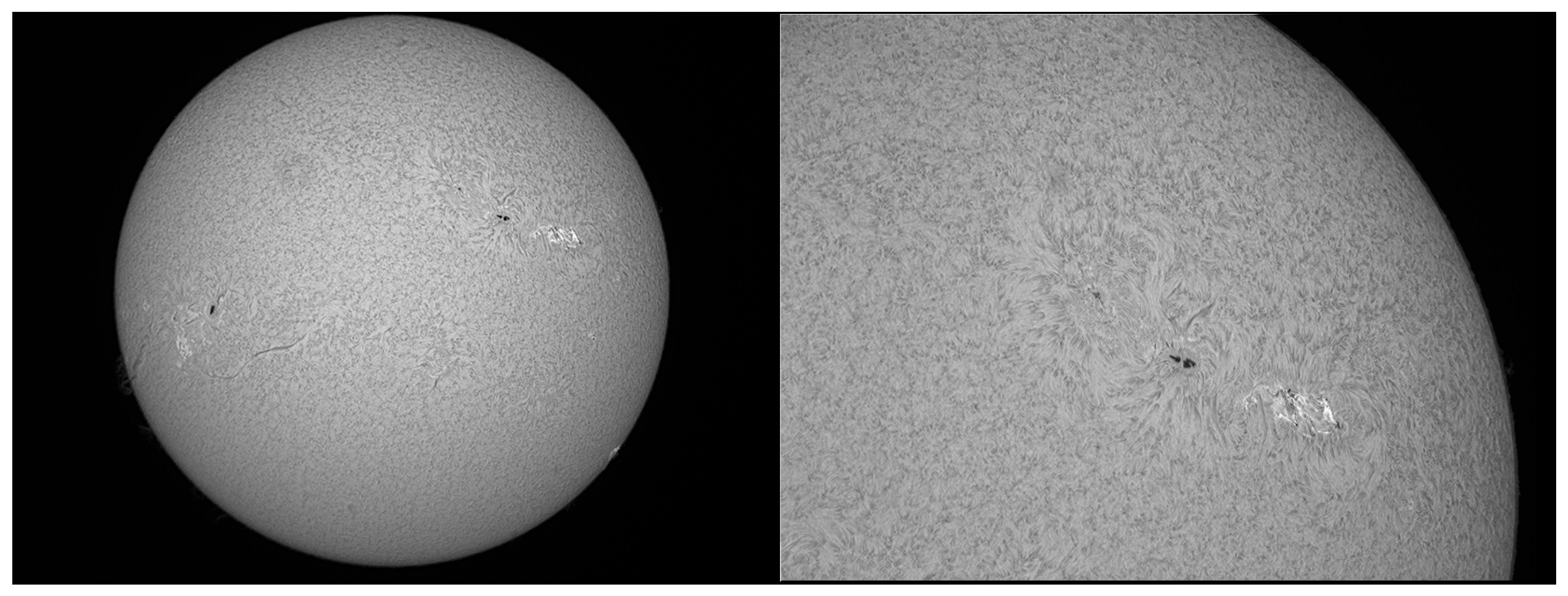

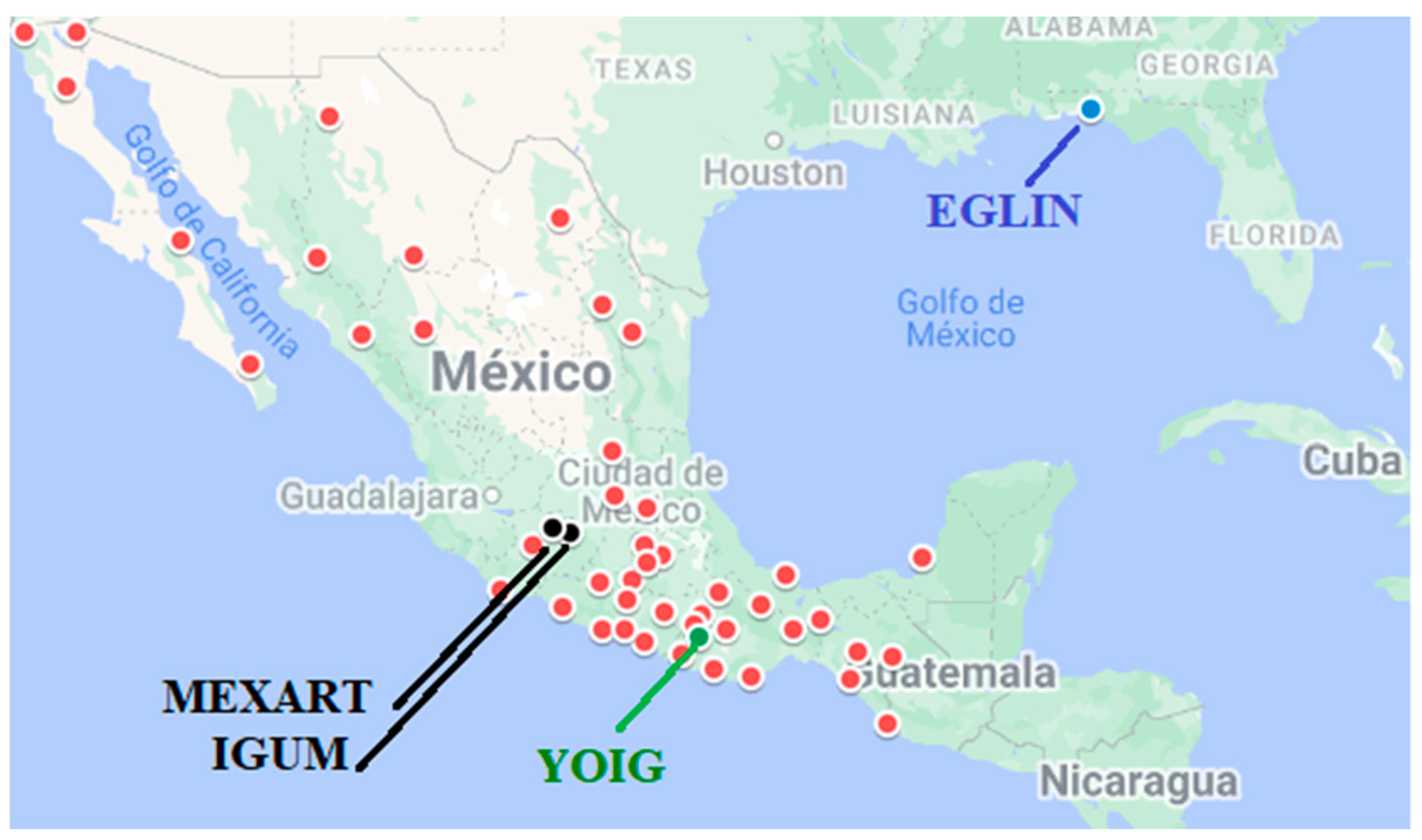


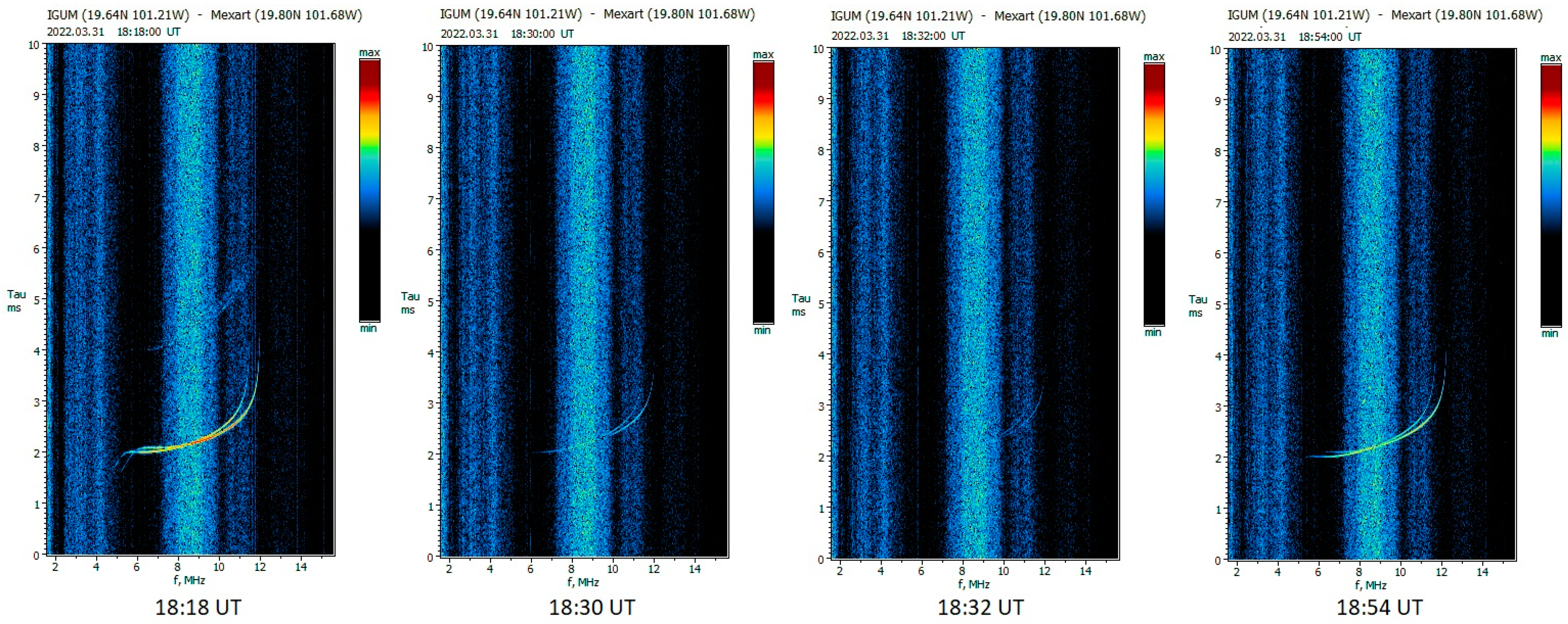

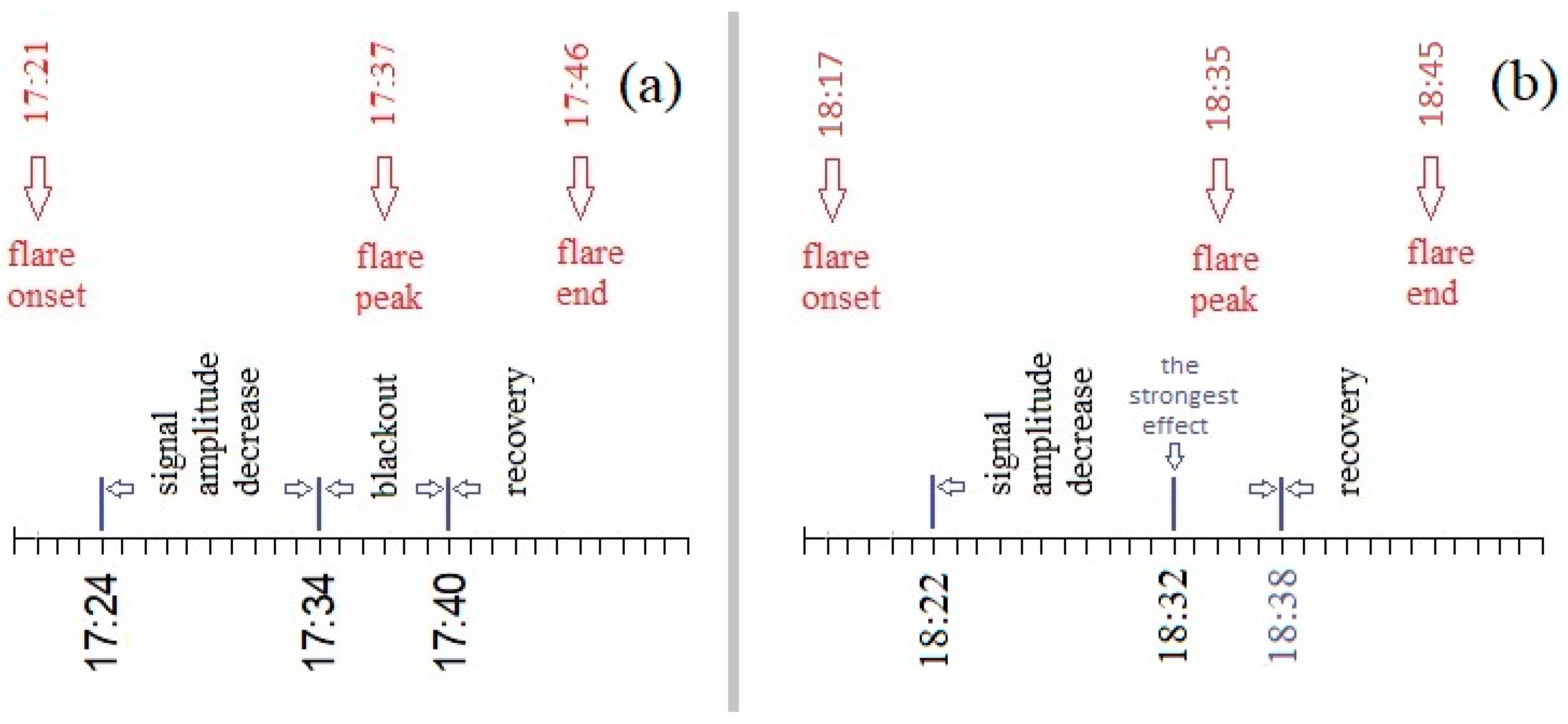
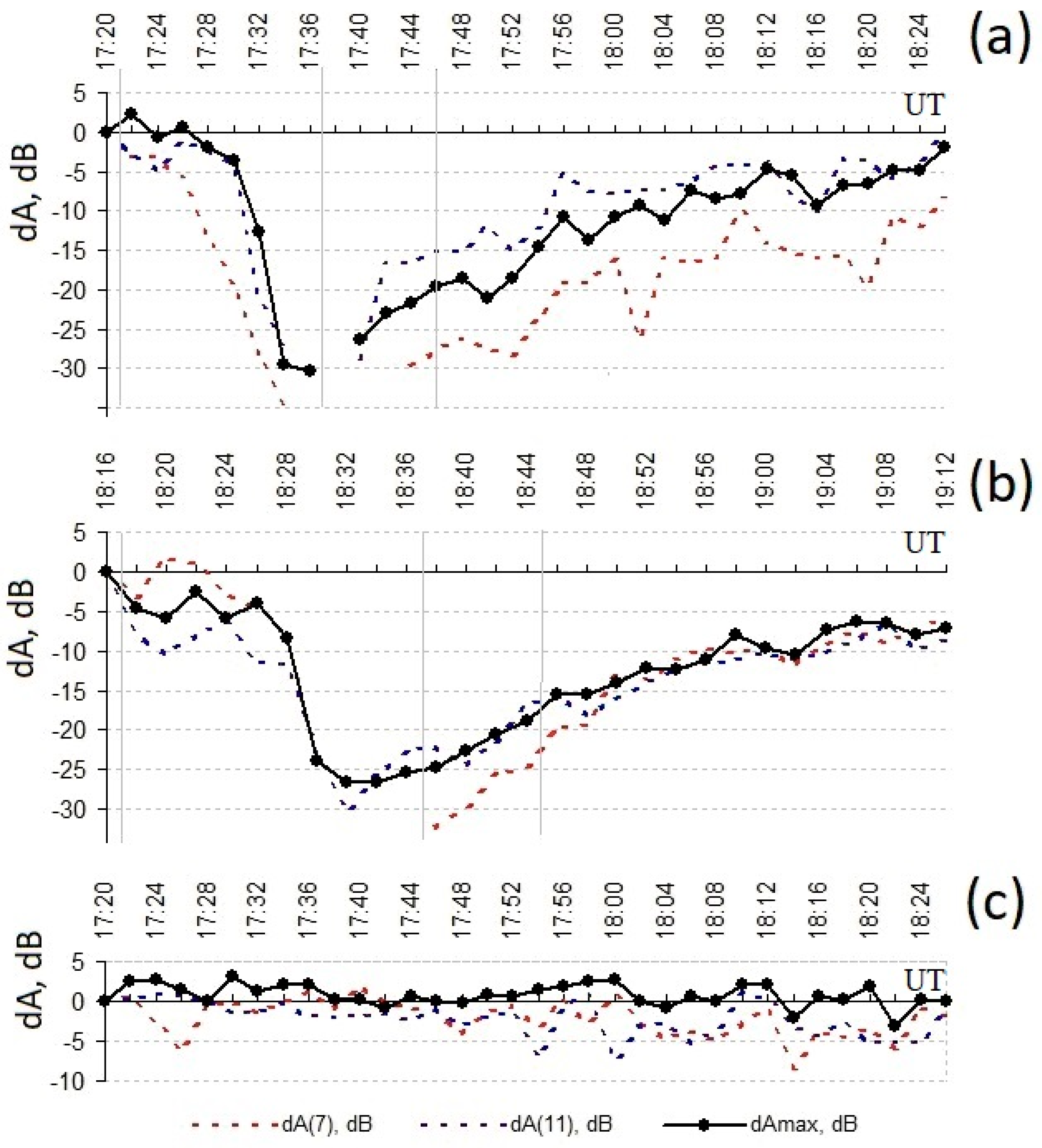
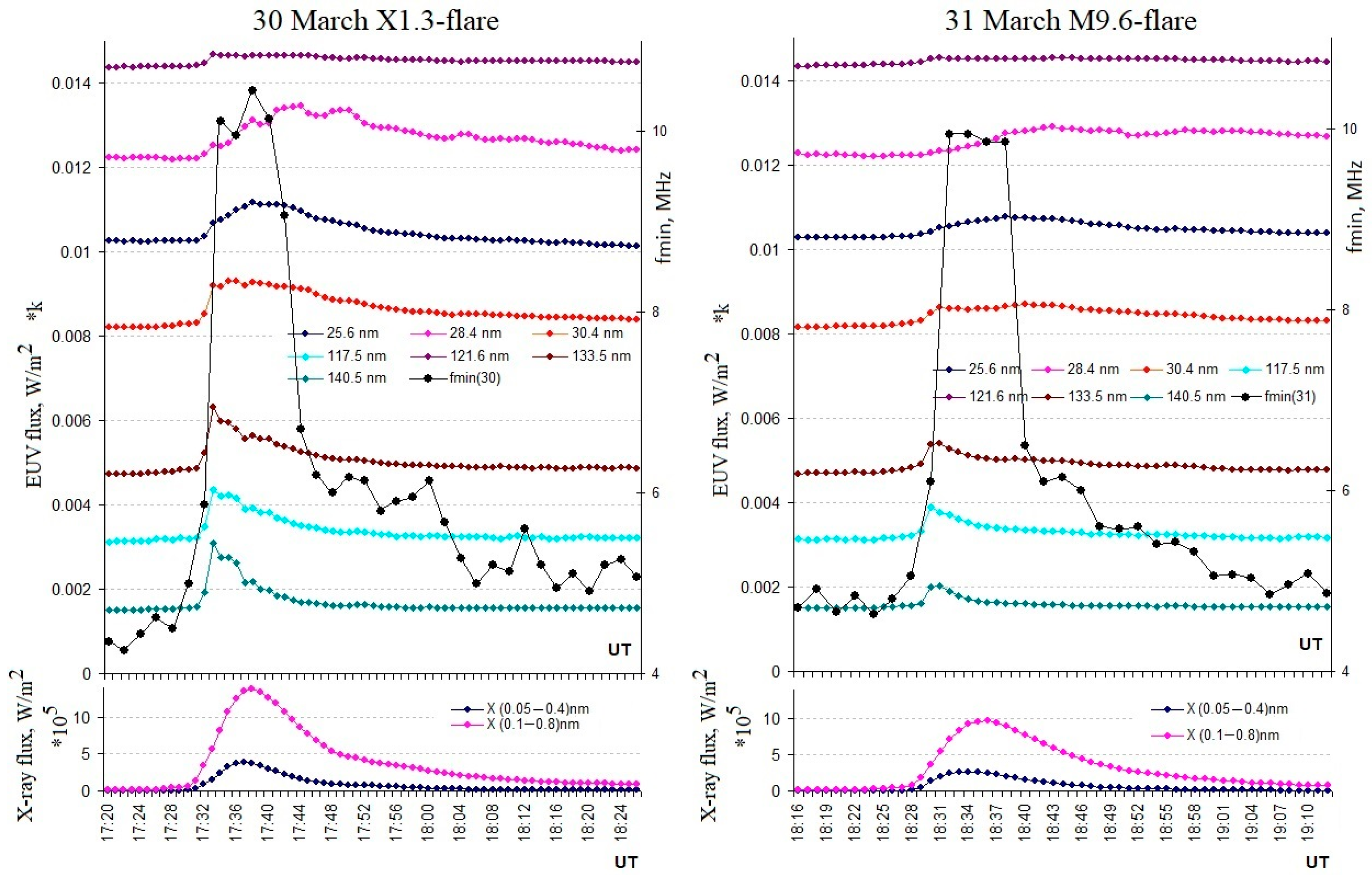

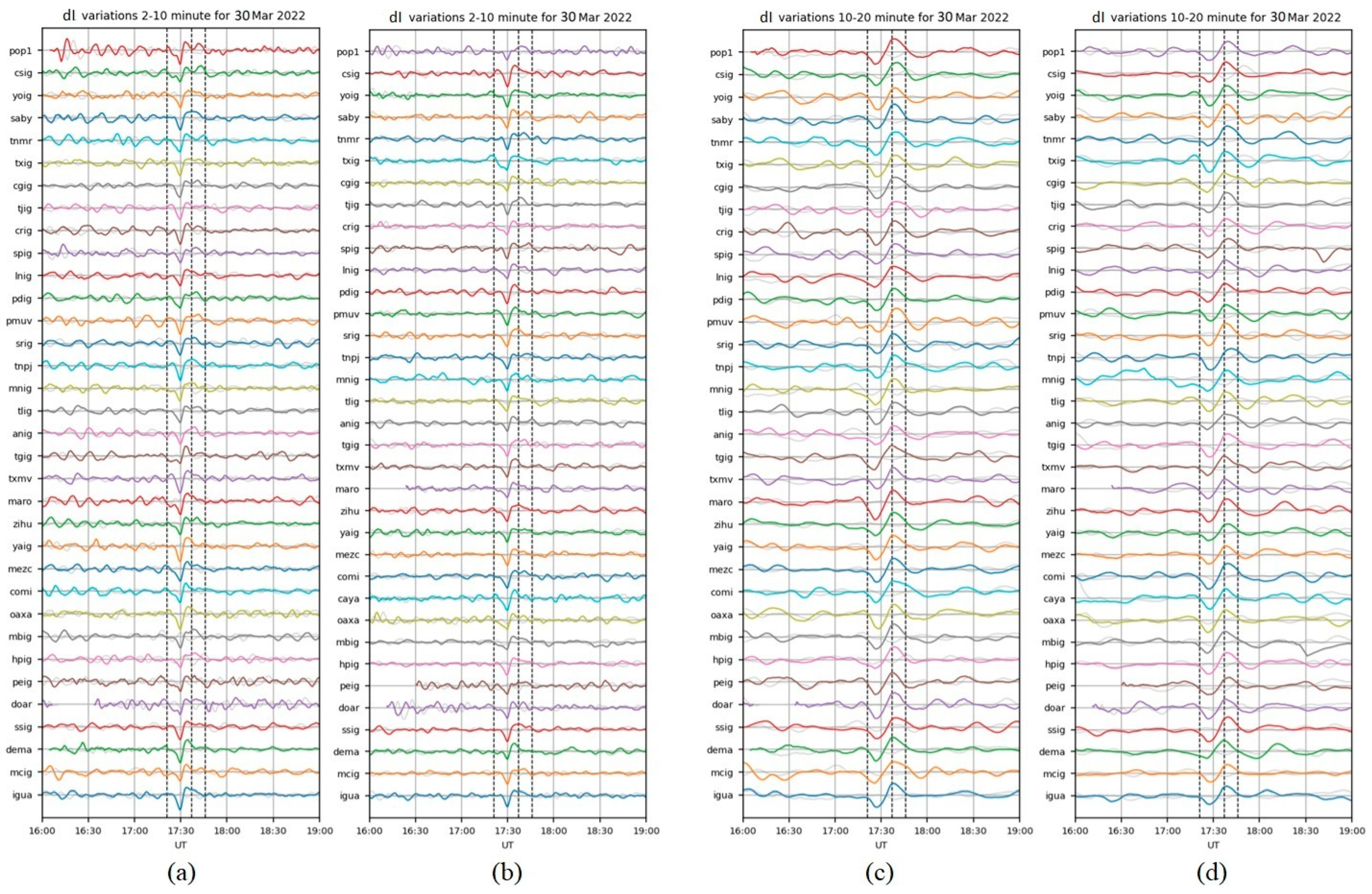
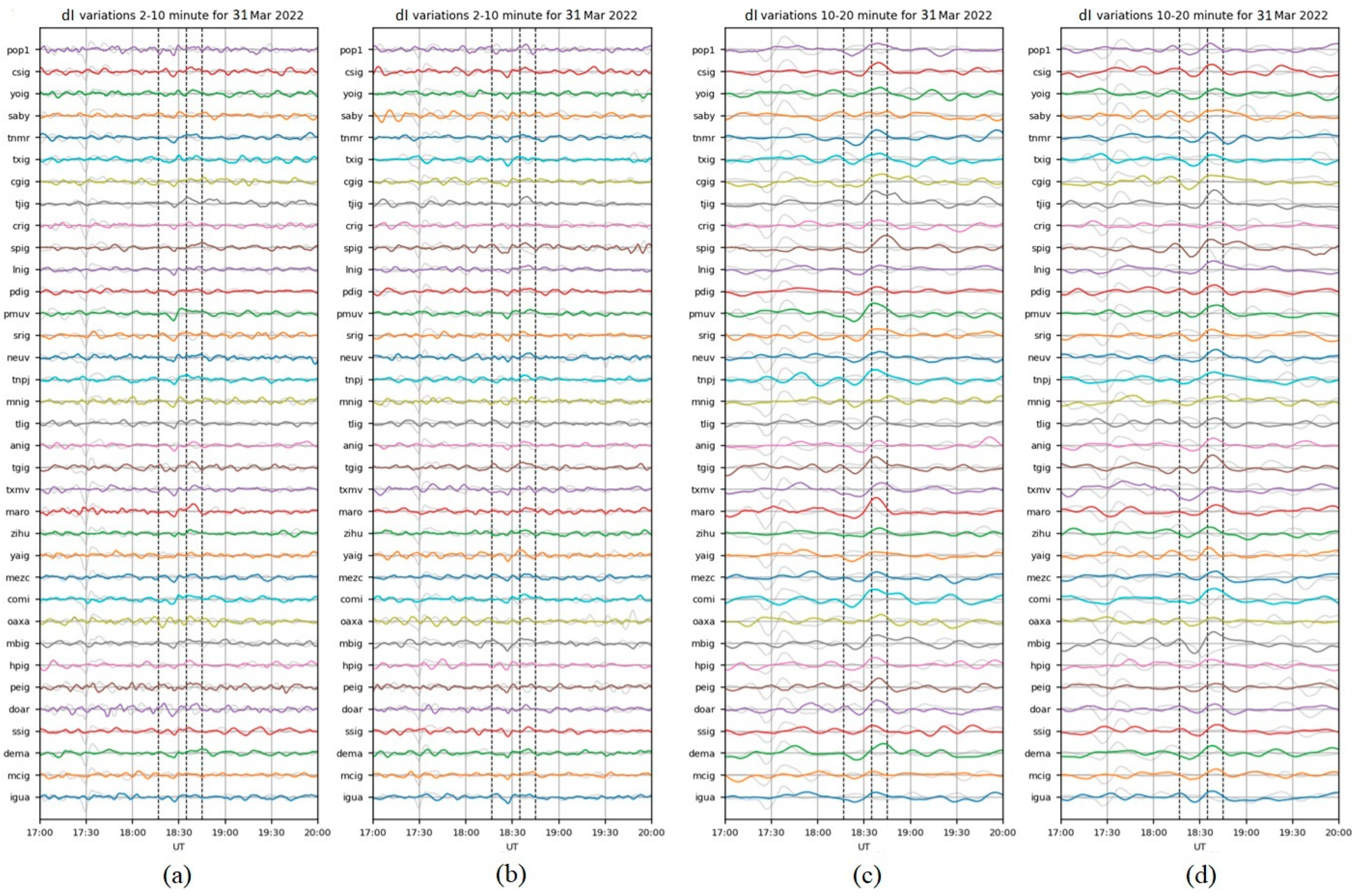
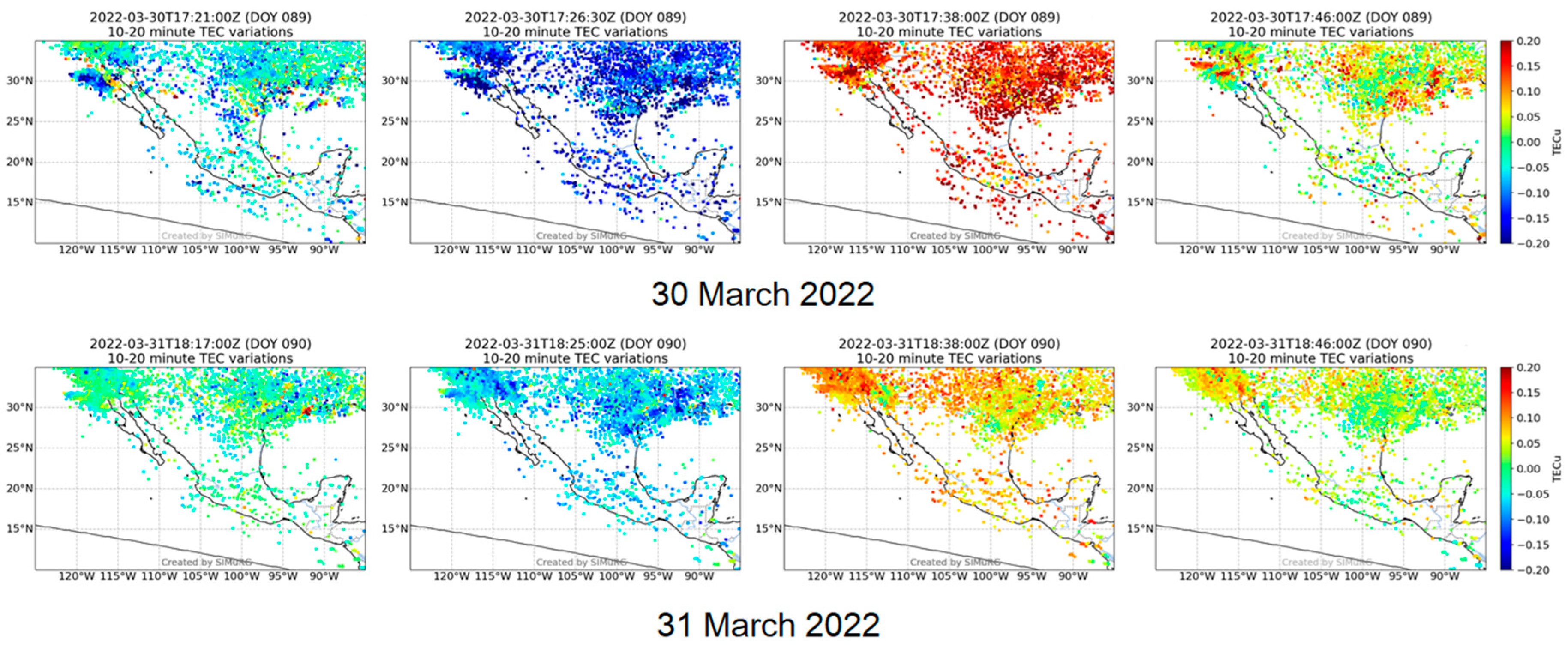

| Date | Flare Onset, UT | Flare Max, UT | Flare End, UT | Duration (Phases), Min | LT = ~(UT-5) | X-Class | AR (Coordinates) | F10.7, s.f.u (at 20 UT) | Dst * (Daily max/min), nT |
|---|---|---|---|---|---|---|---|---|---|
| 30 March 2022 DOY = 089 | 17:21 | 17:37 | 17:46 | 25 (16 + 9) | 12:21 LT | X1.3 | 2975 (N13W31) | 151.3 | 10/−9 |
| 31 March 2022 DOY = 090 | 18:17 | 18:35 | 18:45 | 28 (18 + 10) | 13:17 LT | M9.6 | 2975 (N12W47) | 239.5 | 22/−18 |
| EUV Bands, 30 March 2022 | |||||||
|---|---|---|---|---|---|---|---|
| 25.6 nm | 28.4 nm | 30.4 nm | 117.5 nm | 121.6 nm | 133.5 nm | 140.5 nm | |
| dA(7), dB | −0.75 | −0.65 | −0.85 | −0.70 | −0.79 | −0.76 | −0.56 |
| dA(11), dB | −0.82 | −0.54 | −0.86 | −0.89 | −0.74 | −0.91 | −0.78 |
| dAmax, dB | −0.90 | −0.73 | −0.97 | −0.86 | −0.91 | −0.90 | −0.74 |
| fmin | 0.89 | 0.52 | 0.92 | 0.95 | 0.80 | 0.96 | 0.86 |
| EUV Bands, 31 March 2022 | |||||||
|---|---|---|---|---|---|---|---|
| 25.6 nm | 28.4 nm | 30.4 nm | 117.5 nm | 121.6 nm | 133.5 nm | 140.5 nm | |
| dA(7), dB | −0.91 | −0.54 | −0.93 | −0.67 | −0.81 | −0.82 | −0.53 |
| dA(11), dB | −0.76 | −0.07 | −0.82 | −0.84 | −0.67 | −0.91 | −0.75 |
| dAmax, dB | −0.83 | −0.19 | −0.88 | −0.83 | −0.76 | −0.91 | −0.72 |
| fmin | 0.63 | 0.03 | 0.66 | 0.68 | 0.52 | 0.73 | 0.59 |
| X-ray Bands, 30 March 2022 | ||
|---|---|---|
| (0.05–0.4) nm | (0.1–0.8) nm | |
| dA(7), dB | −0.8 | −0.84 |
| dA(11), dB | −0.91 | −0.88 |
| dAmax, dB | −0.89 | −0.93 |
| fmin | 0.96 | 0.92 |
| X-ray Bands, 31 March 2022 | ||
|---|---|---|
| (0.05–0.4) nm | (0.1–0.8) nm | |
| dA(7), dB | −0.93 | −0.95 |
| dA(11), dB | −0.9 | −0.89 |
| dAmax, dB | −0.93 | −0.94 |
| fmin | 0.96 | 0.91 |
| r (17:20–17:46 UT) | EUV 25.6 nm | EUV 28.4 nm | EUV 30.4 nm | EUV 117.5 nm | EUV 121.6 nm | EUV 133.5 nm | EUV 140.5 nm | X (0.05–0.4) nm | X (0.1–0.8) nm |
|---|---|---|---|---|---|---|---|---|---|
| dI(2-10) | 0.60 | 0.39 | 0.63 | 0.65 | 0.59 | 0.60 | 0.58 | 0.64 | 0.58 |
| dI(10-20) | 0.93 | 0.74 | 0.87 | 0.71 | 0.84 | 0.70 | 0.51 | 0.93 | 0.93 |
| ROTI | 0.51 | 0.17 | 0.68 | 0.92 | 0.63 | 0.90 | 0.95 | 0.54 | 0.43 |
| r (18:16–18:45 UT) | EUV 25.6 nm | EUV 28.4 nm | EUV 30.4 nm | EUV 117.5 nm | EUV 121.6 nm | EUV 133.5 nm | EUV 140.5 nm | X (0.05–0.4) nm | X (0.1–0.8) nm |
|---|---|---|---|---|---|---|---|---|---|
| dI(2-10) | 0.54 | 0.59 | 0.65 | 0.51 | 0.66 | 0.58 | 0.46 | 0.34 | 0.40 |
| dI(10-20) | 0.97 | 0.91 | 0.95 | 0.50 | 0.91 | 0.64 | 0.31 | 0.73 | 0.87 |
| ROTI | −0.44 | −0.44 | 0.51 | −0.54 | −0.59 | −0.58 | −0.50 | −0.34 | −0.35 |
Disclaimer/Publisher’s Note: The statements, opinions and data contained in all publications are solely those of the individual author(s) and contributor(s) and not of MDPI and/or the editor(s). MDPI and/or the editor(s) disclaim responsibility for any injury to people or property resulting from any ideas, methods, instructions or products referred to in the content. |
© 2023 by the authors. Licensee MDPI, Basel, Switzerland. This article is an open access article distributed under the terms and conditions of the Creative Commons Attribution (CC BY) license (https://creativecommons.org/licenses/by/4.0/).
Share and Cite
Sergeeva, M.A.; Maltseva, O.A.; Vesnin, A.M.; Blagoveshchensky, D.V.; Gatica-Acevedo, V.J.; Gonzalez-Esparza, J.A.; Chernov, A.G.; Orrala-Legorreta, I.D.; Melgarejo-Morales, A.; Gonzalez, L.X.; et al. Solar Flare Effects Observed over Mexico during 30–31 March 2022. Remote Sens. 2023, 15, 397. https://doi.org/10.3390/rs15020397
Sergeeva MA, Maltseva OA, Vesnin AM, Blagoveshchensky DV, Gatica-Acevedo VJ, Gonzalez-Esparza JA, Chernov AG, Orrala-Legorreta ID, Melgarejo-Morales A, Gonzalez LX, et al. Solar Flare Effects Observed over Mexico during 30–31 March 2022. Remote Sensing. 2023; 15(2):397. https://doi.org/10.3390/rs15020397
Chicago/Turabian StyleSergeeva, Maria A., Olga A. Maltseva, Artem M. Vesnin, Donat V. Blagoveshchensky, Victor J. Gatica-Acevedo, J. Americo Gonzalez-Esparza, Aleksandr G. Chernov, Isaac D. Orrala-Legorreta, Angela Melgarejo-Morales, Luis Xavier Gonzalez, and et al. 2023. "Solar Flare Effects Observed over Mexico during 30–31 March 2022" Remote Sensing 15, no. 2: 397. https://doi.org/10.3390/rs15020397
APA StyleSergeeva, M. A., Maltseva, O. A., Vesnin, A. M., Blagoveshchensky, D. V., Gatica-Acevedo, V. J., Gonzalez-Esparza, J. A., Chernov, A. G., Orrala-Legorreta, I. D., Melgarejo-Morales, A., Gonzalez, L. X., Rodriguez-Martinez, M., Aguilar-Rodriguez, E., Andrade-Mascote, E., & Villanueva, P. (2023). Solar Flare Effects Observed over Mexico during 30–31 March 2022. Remote Sensing, 15(2), 397. https://doi.org/10.3390/rs15020397







